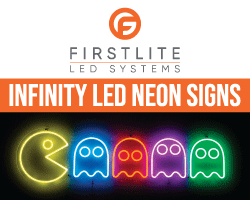Expert advice from Marcus Clifford.

Find other articles by Marcus Clifford on Eye on Display here.
Hear me out.
After reading this, you will appreciate that I am on the salesperson’s side. It is one of the noblest professions, and it requires a potent mixture of skills, mindset, and great resilience.
A successful sales professional navigates a delicate balance, aiming to meet clients’ needs through a combination of knowledge, expertise, and integrity. This demands a deep comprehension of both business and human dynamics. Charisma helps, but it’s not the pivotal trait for a salesperson; instead, exceptional listening and comprehension skills and insights into business strategy, objectives, and supporting processes define truly effective salespeople.
As LinkedIn highlighted in a recent report, sales is the second-most common first-job function for CEOs! So keep the faith and charge on you good salespeople.
I did some work a few years ago with an interesting American, Dallas Dort, who compiled a programme to measure competitive advantage in the eyes of the customer. Customers buy competitive advantage from those who provide them with more of it.
He identified 16 simple points of differentiation that all companies can deliver, but many don’t. I liked that the whole company was enlisted to deliver a competitive advantage once the salesperson engaged the customer to discuss it. It was the company’s responsibility to deliver the platform for growth, and in so many instances today, I see the expectation that the salesperson has the responsibility to manage things they cannot influence.
A greater covenant is needed between those who are selling and the company requiring a culture and mindset of innovation. Everyone has responsibility for selling. A clear and strong value proposition needs to be enunciated and delivered.
Create a better vision that links meaning and purpose internally to the changed needs of your customers as part of the growth equation.
Is it a truism that people buy because they need something? They need to buy from someone, but much has changed in the process. Competition is greater, customers’ expectations are different, and companies interact with each other to a greater degree. The role of a salesperson has changed, and so has the role of selling, so new engagement and communication strategies, processes, and tactics are required.
What has changed?
The demographics of those who buy have changed. We live in an expectancy economy where buyers take their buying experiences from non-business experiences. McKinsey research suggests that around 75% of customers in the B2B space prefer digital self-serve and have become used to a remoter human interaction via virtual meetings.
Informed buyers are delaying engagement with salespeople, which limits understanding and influence. Decentralised decision-making and informal influencers complicate matters. A different approach to communicating and influencing is required.
Suppliers are checked out prior to any purchase, and so a supplier needs to ensure a build-up of relevant and value-added information is interesting and compelling. Research by Gartner CEB, ‘Navigating successfully through the evolving buying journey’, highlights that 57-80% of all B2B buying journeys are completed before any direct sales enquiry. Therefore, engaging customer interest is now a business imperative, as is incorporating a digital-first communications approach.
We have seen new business models reshaping our sector, and the B2B customer displays many of the B2C traits. What does this mean? It means we need to introduce technology which offers a blended experience of knowledge and information and relevant online access points for our customers.
We have such an online interfaces, digital processes, self-serve and self-update channel tools. We are ready, but we need to use them to review what a good experience looks like and ensure we have the right balance. At any point of human or digital interaction, internal and external alignment of value needs to be at the forefront of managing the customer experience. Silos and structures that create separate departmental responsibilities are not relevant now and are not good for maximising sales development.
Pipeline development has changed and takes longer. Sales targets are often set for the short term, while business development goals take longer to achieve.
Customers don’t like to be sold at. It’s a turn-off. Titles and approaches are now more important to cut through and create a needed impression. Job titles need to encompass so much more, and they are a differentiator that sets you apart from your competition. So, sales executive, sales director, and business development titles are too limiting.
I often talk to sales teams about assuming the language of the marketeer and changing their titles to incorporate marketing. Customers prefer to talk to them backed up by inciteful and researched options that resonate.
This is a small shift, but consider the limiting nature of current job titles and how customers might be intrigued and interested in different ones that more reflect the nature of meaningful engagement. Director of Understanding, Director of first Impressions, Director of Innovation, Boosterologist! Engagement Designers, Customer Engagement Champion, Value Engineer, Customer Whisperer. Have some meaningful fun. It works!
Customers see you as a Brand
This creates the need to manage your brand and its values, which all your employees are part of, not a single function, team, or person. As Doug Conant, CEO of Campbell’s Soup, said, ‘To win in the marketplace, you must first win in the workplace.’ Soup and Print come together!
We are a service-led sector and have many great initiatives in place, but the ingredients and equation of sales have changed, and the role of sales has changed. We need to enunciate what value will be experienced as a customer through all available channels in a unified way.
On top of this change in buyer behaviour and expectancy, and whilst our sector has developed more robust business models, we are in a cycle of volatility, ambiguity, complexity and uncertainty (VUCA). Revenue cycles are still the hardest issue to forecast, and customer relationships can be fickle. Hence the whole business needs to own relationships not one or a few, The risks of losing are too high.
What does better look like to reduce your risk? Be ahead of the curve
Everyone in a business now needs to feel a genuine responsibility to protect, build and grow the business they work in. Creating a culture that enshrines this, has big benefits, not least in enabling stronger sales growth.
In the trade press it was announced that a recent acquisition by a large group was being put into administration as a result of significant sales revenues falling away post acquisition. I wrote recently about who owns accounts and who is responsible for relations and communicating the ground truth of what is really occurring. The whole company should own the account and fundamentally understand all the issues. It’s not just too important to be left to a salesperson, but it’s unfair to be left to only a few who might or might not be able to influence.
And why all staff, especially ‘sellers’—which now includes anyone who has any interaction with a customer—should see themselves as revenue officers, value engineers, and champions of growth. It’s a mindset and a process that has huge benefits.
As part of an inclusive strategy, the Company needs to own business growth and take an inclusive and holistic view across business engagement and growth strategies. Sales are now too important to be one function’s responsibility, and the seller needs greater support to combat and manage the customer’s and market requirements.
Some considerations now as a result of change
The disconnect between a salesperson and marketing needs to be connected. The seller needs to think and act like a marketeer.
Problem-solving, Innovation, translation, and development of a strong value proposition that resonates with customers or segments is a team effort in which the seller is part of the process and a translator and communicator to customers, but not solely.
With different product and service lines now being offered by Print service providers and the need to track profitability and cost to a greater degree, difficulty plotting and forecasting revenue patterns due to VUCA and the opportunity to create interactions based on the value the principles of category management need to be reviewed. As customers have changed and the servicing of different segments has become more bespoke, a strategic approach is required to manage product strategies and customise marketing mixes for each category based on their unique characteristics. To best develop and manage customers, we have the data via our mis and information management systems. The step change is not onerous but a required one to maximise sales and profits for a greater
Effective growth now requires integrated marketing strategies that go beyond traditional sales efforts. Digital marketing, content creation, social media engagement, and other marketing initiatives create brand awareness, generate leads, and support the sales process. A cohesive approach involving both sales and marketing is more likely to yield positive results.
Sustainable growth is linked to continuous product development and innovation. Relying solely on sales teams limits the company’s ability to identify new market opportunities, adapt to changing customer needs, and stay ahead of competitors. All need to be involved.
Data-Driven Decision Making:
In today’s data-driven business environment, decisions require greater accurate and timely information. Analysing market trends, customer behaviour, and performance metrics requires input from various departments, including finance, analytics, and operations. Investment in latest technology, investment in the wrong technology or equipment puts your business model at risk. Involve everyone in a process.
Holistic Business Strategy:
Growth is best achieved through a holistic business strategy that considers all aspects of the company. This includes aligning organisational goals, optimising resource allocation, and fostering a culture of innovation. The sales team is just one component of this larger strategic framework.
I still see too many organisations putting revenue growth in the hands of sales and displaying disengaged silos without the proper engaged and holistic support. It’s too important to leave it to salespeople. Beef up their support, beef up their function, beef up everyone else’s responsibility
FutureCurve plots and researches changed requirements in customers and suppliers and it suggests a supplier needs to fully identify its vision and the Why:
- Fully explore its customers’ markets
- Understand its customers in a quantitative and qualitative manner
- Prioritise its services
- Clarify its real value to customers
- Create competitive differentiation
- Generate value messaging.
Go on a Customer Safari with the team who engage at all points. It’s a wider business requirement and beyond just one function.
In summary, while the sales team is instrumental in revenue generation, a successful growth strategy involves collaboration across multiple functions within the organisation. A comprehensive, cross-functional approach that considers marketing, customer service, product development, and operational efficiency is more likely to lead to sustained and scalable growth in today’s competitive markets.

















